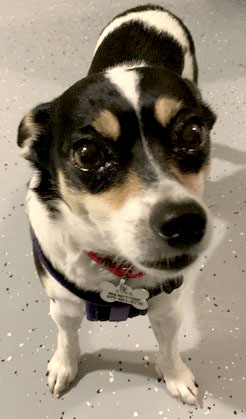1. ID Tag …. 2. Transition …. 3. Housetraining …. 4. Feeding
5. Fleas & Ticks …. 6. Heartworms …. 7. Poison Control …. 8. First Aid Kit
9. Marker Training …. 10. Aggression …. 11. Resources & Recommended Reading

Many dogs who show perfect house manners in one home will nevertheless have accidents in the transition to a new home. You and your new dog need some time to learn each other’s signals and routines. Even if he was housetrained in his previous home, if you don’t recognize his “bathroom” signal, you might miss his request to go out, causing him to potty indoors. Any change in schedule or family situation, new smells, new sounds, new personalities, and new routines can set off a bout of mistakes. If coming from a shelter, the dog may not have gotten enough opportunities to potty outside, and consequently soiled the kennel area, weakening housetraining habits. Scents and odors from other pets in the new home may also stimulate some initial urine marking.
For the first several days or even weeks after bringing a new dog home, it’s best to assume that he is NOT housetrained and start from scratch. If he was housetrained previously, the re-training process should progress quickly. The process will be much smoother if you take steps to prevent accidents and remind him where he’s supposed to potty.
Establish A Routine
—Take your dog out at the same times every day.
— Every time he potties outdoors, praise him lavishly and give him a treat immediately after he’s finished. Don’t wait until after you come back inside. Rewarding for pottying outdoors is the only way he’ll know that’s what you want him to do.
—Choose a location not too far from the door to be the bathroom spot. Always take him, on leash, directly to this spot. Don’t take him for a walk or play with him until AFTER he’s pottied. If you clean up an accident in the house, place the soiled rag or paper towel in the bathroom spot. The smell will help your dog recognize the area as the place where he’s supposed to potty.
—While your dog is pottying, use a word or phrase like “go potty,” for example, that you can eventually use before he eliminates to remind him of what he’s supposed to be doing.
—Feeding your dog on a set schedule, once or twice a day, will help make his pottying more regular.
Supervise, Supervise, Supervise
Don’t give your new dog an opportunity to potty indoors. He should be watched at all times when in the house. You can tether him to you with a 6-foot leash or use baby gates to keep him in the room where you are. Watch for signs that he needs to potty, like sniffing or circling. If you see these signs, take him out immediately, on a leash, to his designated spot. If he potties, praise lavishly and reward with a treat.
Confinement
When you’re unable to watch your dog at all times, he should be confined to an area small enough that he won’t want to potty there. It should be just big enough for him to comfortably stand, lie down, and turn around in. This could be a portion of a bathroom or laundry room blocked off with boxes or baby gates. Or you may want to crate train your dog and use the crate to confine him.
Oops!
Most dogs, at some point, will have an accident in the house. You should expect this, as it’s a normal part of your dog’s adjustment to his new home. If you catch your dog in the act of pottying in the house, do something to interrupt him like making a startling noise (don’t scare him). Immediately take him to his designated spot, praise him, and give him a treat if he finishes pottying there.
Don’t punish your dog for pottying in the house!!! If you find a soiled area, it’s too late to administer a correction. Do nothing but clean it up. Rubbing your dog’s nose in it, scolding him, or any other type of punishment will only make him afraid of you or afraid to potty in your presence. Animals don’t understand punishment after the fact, even if it’s only seconds later.
Cleaning the soiled area is very important because dogs are highly motivated to continue soiling in areas that smell like urine or feces. Use an enzyme cleaning product specifically for animal stains, such as Simple Solution or Nature’s Miracle.
1. ID Tag …. 2. Transition …. 3. Housetraining …. 4. Feeding
5. Fleas & Ticks …. 6. Heartworms …. 7. Poison Control …. 8. First Aid Kit
9. Marker Training …. 10. Aggression …. 11. Resources & Recommended Reading